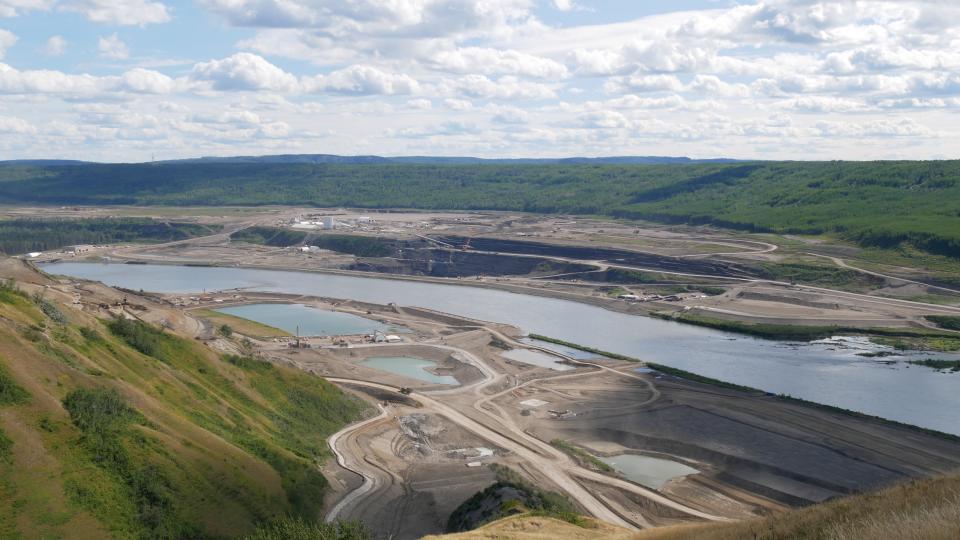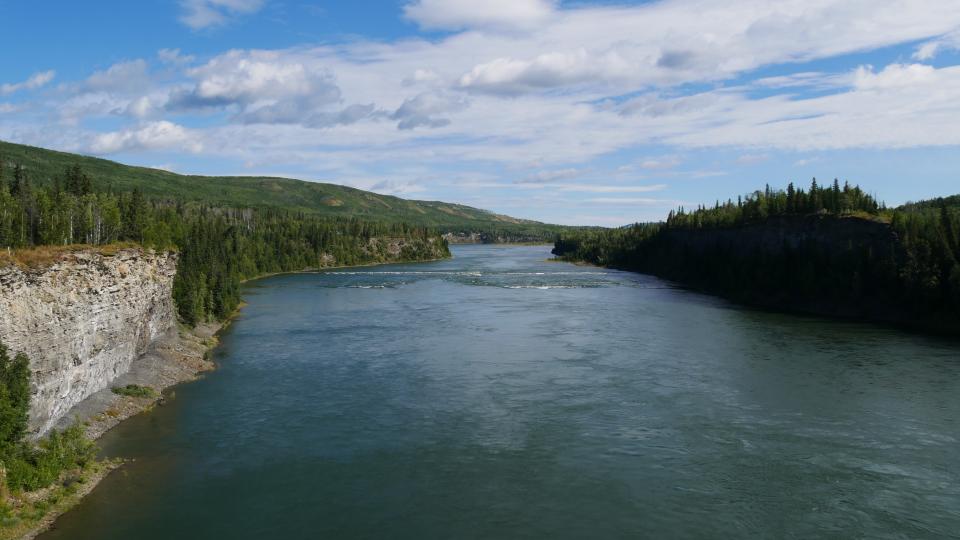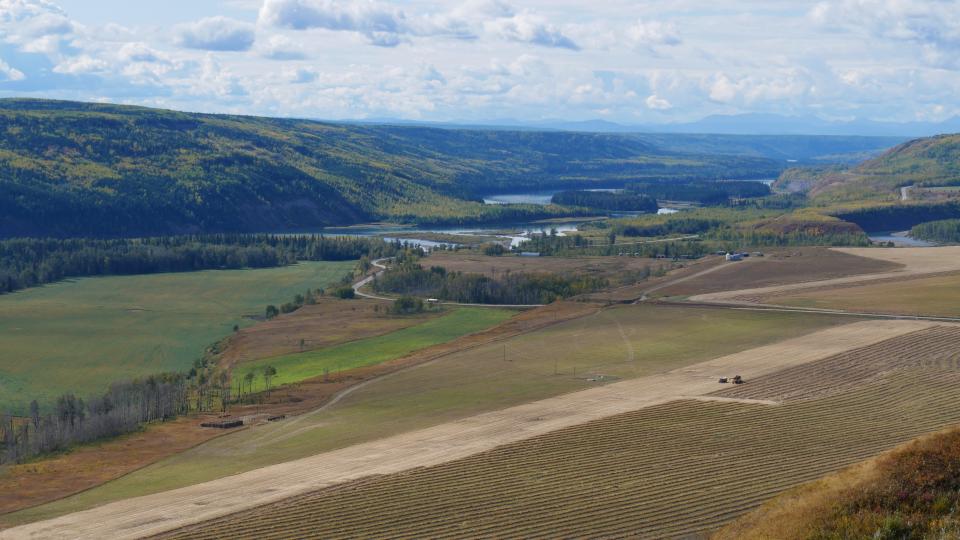During harsh weather conditions in December 2015, farmers, ranchers, and First Nations came together to camp in the woods for 62 days in the so-called Rocky Mountain Fort occupation in opposition to the construction of the third hydroelectric dam in the Peace River Valley. Two years later, in December 2017, after the final evaluation by the British Columbia Utilities Commission, the government decided that the construction of the Site C dam—operated by BC Hydro, a corporation owned by the provincial government—will continue. Since the initial announcement about 40 years ago the project has been accompanied by controversial debates within the local population, with discourses touching on a number of issues including the high costs of construction, the environmental impact, the loss of homes, the neglect of local culture, and the loss of valuable agricultural land.

The Site C construction site before the flooding.
The Site C construction site before the flooding.
Photograph by Elisabeth Fajt.
 This work is licensed under a Creative Commons Attribution 4.0 International License.
This work is licensed under a Creative Commons Attribution 4.0 International License.
The Peace River Valley is located in western Canada, in the northeast of British Columbia. In the Peace Region there is not only high biodiversity but also fertile soils and natural resources. The extensive development of oil and gas remains crucial for the local economy. In 1899 an agreement between indigenous Chiefs and the Canadian government was ratified, creating the Treaty 8 area and granting rights for the use of this land and its resources to local indigenous communities without the need to acquire permits (Treaty No. 8, 1899). The construction of Site C is taking place on land protected by the treaty and, as a consequence, a large part of it will be flooded, destroying important trapping and hunting areas.
The local First Nation communities—Salteau, Prophet, and West Moberly First Nations—will lose not only their food resources but also culturally significant locations such as historical sites, spiritual places, and burial sites. As Jeremy, a Saulteau member and ecological activist, stresses in an interview:
When we lose the ability to practice our most important cultural activities as time goes we become just like everyone else. We lose those things that make us Dane-Zaa, that make us Cree. (Interview Jeremy, 30 August 2017.)1
The Elders of the Dane-za and Cree communities describe Site C as a neocolonial continuation of the suppression of their rights by political powers. Art, a former Saulteau Chief, pointed out in an interview that “they want to be able to believe that we’re inferior, you know we’re savage and that we’re not productive on our lands. Therefore they need to have that association that we should be lucky that they’re exploiting our land.” (Interview Art, 30 August 2017.)

The Peace River and the spiritual islands that will be inundated.
The Peace River and the spiritual islands that will be inundated.
Photograph by Elisabeth Fajt.
 This work is licensed under a Creative Commons Attribution 4.0 International License.
This work is licensed under a Creative Commons Attribution 4.0 International License.
However, not only First Nations have been affected by the construction: the valley has been used for agriculture since the first settlers arrived to the Peace. For many generations families have owned farming and ranching businesses which now have been lost to the construction, as a local farmer explains:
We’ve been expropriated here. So BC Hydro owns this property with this house that our grandfather has built. And if the project goes ahead that bottom part of the property would be flooded and this would be a highway. (Interview Mike, 2 October 2017.)
Another impact of Site C will be the destruction of an area that holds agricultural significance in terms of food security for the entire province, due to its fertile land and the climate in the valley being exceptional in the province. This was mentioned in my interview with a biologist and former teacher:
Particularly in the summer the valley heats up, it’s like a little cauldron. And the temperature difference between here and down at the bottom might be 15 degrees Celsius. So we have very good top soil, up to 2–3 meters of top soil in some places and warm temperatures and lots of water. And in the summer time here 18 hours of daylight! And you combine all of that and that’s why were getting cantaloupes and watermelons. (Interview Ken, 19 September 2017.)
Additionally, previous projects such as the W. A. C. Bennet Dam (1969) have shown consequences for the migration routes and habitats of local animals (e.g., eagles, cariboo, and fish populations) which have been fundamentally altered by the flooding.

A farm in the Peace River Valley that will be flooded.
A farm in the Peace River Valley that will be flooded.
Photograph by Elisabeth Fajt.
 This work is licensed under a Creative Commons Attribution 4.0 International License.
This work is licensed under a Creative Commons Attribution 4.0 International License.
From the beginning of the project, there has been a resistance movement against the construction of Site C organized through several NGOs including the Peace Valley Environmental Association (PVEA). Based on the government’s lack of compliance with their constitutional duty to consult with First Nations on every resource project on treaty land, this movement has initiated a number of court cases on the provincial as well as the federal level. None of them have been successful. This, however, has not diminished hope, with the election of a Liberal government in 2017 giving new momentum. However, this did not change the situation and it still is not clear where and how the generated energy will be used.

One of many protest signs against Site C at a farm in the Valley
One of many protest signs against Site C at a farm in the Valley
Photograph by Elisabeth Fajt.
 This work is licensed under a Creative Commons Attribution 4.0 International License.
This work is licensed under a Creative Commons Attribution 4.0 International License.
Politically, Site C has always been positioned within the “Clean Energy” narrative as a beacon of sustainability in the fight against rise of toxic emissions. But at the same time it serves as another example of the conflict and the fine line between global environmental protection and sustainability, and local destruction—as well as the power struggle between local and indigenous communities and governments and corporate interests. Within this struggle the resistance movement gives a voice to the otherwise “silent” Peace River Valley and embodies a certain power vis-à-vis the political decision-makers, even if it has been unsuccessful to this point.
1 For the personal protection of some interviewees I have anonymized their names.
How to cite
Fajt, Elisabeth. “Voices of the Peace.” Environment & Society Portal, Arcadia (Summer 2020), no. 32. Rachel Carson Center for Environment and Society. https://doi.org/10.5282/rcc/9100.
ISSN 2199-3408
Environment & Society Portal, Arcadia
 This work is licensed under a Creative Commons Attribution 4.0 International License.
This work is licensed under a Creative Commons Attribution 4.0 International License.
2020 Elisabeth Fajt
This refers only to the text and does not include any image rights.
Please click on the images to view their individual rights status.
- Brody, Hugh. Maps and Dreams: Indians and the British Columbia Frontier. London: Faber and Faber, 2002 [1981].
- Burley, David V., J. Scott Hamilton, and Knut R. Fladmark. Prophecy of the Swan: The Upper Peace River Fur Trade of 1794–1823. Vancouver: UBC Press, 1996.
- Church, Michael, Tina Loo, and Meg Stanley. “An Environmental History of Progress: Damming the Peace and Columbia Rivers.” Journal of Environmental Assessment Policy and Management 92, no. 3 (2018): 399–427.
- Holm, Wendy, ed. Damming the Peace: The Hidden Costs of the Site C Dam. Toronto: James Lorimer & Company Ltd., 2018.
- Pollon, Christopher. The Peace in Peril: The Real Cost of the Site C Dam. Madeira Park: Harbour Publishing, 2016.
- Pollen, Earl K., and Shirlee Smith Matheson. This Was Our Valley. Calgary: Detselig Enterprises Ltd., 1989.








